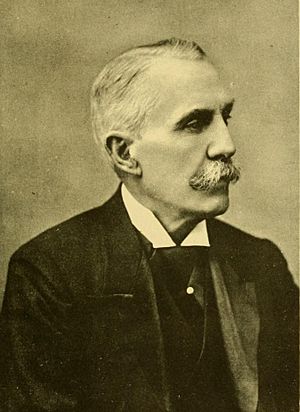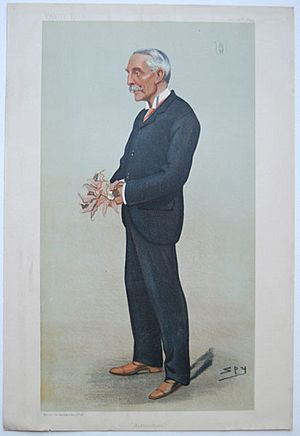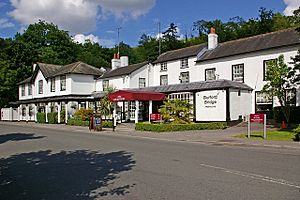Sir Trevor Lawrence, 2nd Baronet facts for kids
Quick facts for kids
Sir
Trevor Lawrence
KCVO KStJ
|
|
|---|---|
 |
|
| Born |
James John Trevor Lawrence
30 December 1831 |
| Died | 22 December 1913 (aged 82) |
| Nationality | British |
| Alma mater | Winchester College St Bartholomew's Hospital |
| Occupation | Surgeon, politician, horticulturalist |
| Spouse(s) | Elizabeth Matthew |
| Children | William Matthew Trevor Lawrence, Aubrey Trevor Lawrence, Charles Trevor Lawrence, Bessie Mary Lawrence |
| Parents |
|
Sir James John Trevor Lawrence, 2nd Baronet (born December 30, 1831 – died December 22, 1913) was an important British person. He was a surgeon, a plant expert, and a collector of art. He also became a politician for the Conservative Party.
Sir Trevor Lawrence was a Member of Parliament (MP) for 17 years. An MP is a person elected to represent people in the British Parliament. After his time as an MP, he became the treasurer (money manager) of St Bartholomew's Hospital. He started the Lawrence Scholarship there, which helps students. He also helped the King Edward's Hospital Fund.
While he was an MP, Sir Trevor Lawrence became the president of the Royal Horticultural Society. This society is all about plants and gardening. He led the society for 28 years until he passed away. During his time, more and more people became interested in gardening and joined the society.
Sir Trevor Lawrence was so important in the world of plants that a special type of Iris flower was named after him: Iris Sir Trevor Lawrence. Also, a group of orchids called Trevoria was named in his honor. The Royal Horticultural Society also created a gold medal in his name.
Contents
Early Life and Family
Trevor Lawrence was born on December 30, 1831. His parents were Louisa Senior and Sir William Lawrence. His mother's father was a successful shop owner in London. He bought a large country home called Broughton House.
Trevor went to Winchester College for school. Then he studied at St Bartholomew's Hospital to become a surgeon. In 1853, he earned his diploma to be a surgeon. After that, he worked for almost ten years with the Indian Medical Service in India.
His mother loved orchids very much, and Trevor inherited this interest. He became even more interested in orchids while he was in India. He started his first collection of orchids when he lived in Dharamsala, which is in the Himalayan mountains.
On July 5, 1867, Trevor Lawrence became the 2nd Baronet after his father. A baronet is a special title of honor that is passed down in a family. In 1869, he married Elizabeth Matthew. Elizabeth's father was a partner in a big engineering company.
Elizabeth inherited a home called Burford Lodge in Dorking. There, she and Trevor created a very famous garden at the bottom of Box Hill. They had three sons and one daughter:
- William Matthew Trevor Lawrence (born 1870 – died 1934)
- Bessie Mary Lawrence (born 1877 – died 1944)
- Aubrey Trevor Lawrence (born 1879 – died 1930)
- Charles Trevor Lawrence (born 1881 – died 1953)
Becoming a Politician
In 1874, Trevor Lawrence tried to become a Member of Parliament (MP) for Gloucester, but he didn't win. However, in 1875, he was elected as an MP for Mid-Surrey. This area included a big part of south London. He was an MP for this area for ten years.
After some changes to the election areas in 1885, he was elected for the Reigate Division in Surrey. He held this seat for seven years. He decided not to run for election again in 1892.
In Parliament, he mostly focused on issues important to his local area. For example, he worked to remove tolls (fees) on bridges over the River Thames. He also cared a lot about public health. He was a strong supporter of vaccinations, which help protect people from diseases.
His Love for Plants and Gardens
Sir Trevor Lawrence's biggest passion was horticulture, which is the art and science of growing plants. He got this interest from his mother, who was also a skilled gardener.
From 1885 to 1913, he was the President of the Royal Horticultural Society. During his time as president, the society grew a lot in members and resources. He wanted the society to focus purely on gardening and plants, rather than just being a place for entertainment. He was key in moving the society from its expensive location in Kensington to a more practical home in Westminster in 1904.
The Royal Horticultural Society honored him many times. They gave him the Victoria Medal of Honour in 1900. A famous artist painted his portrait in 1906. He also received the Veitch Gold Memorial Medal in 1913. The society also created the Lawrence Gold Medal in his honor.
Sir Trevor Lawrence was one of the world's top collectors of orchids. He hired several artists to draw his orchid collections. After he passed away, his wife gave 580 of his special plants to the Kew Gardens.
In 1899, he led a big conference for the Royal Horticultural Society about how plants can be hybridized (mixed to create new types). This meeting is now seen as the first international conference on genetics, which is the study of how traits are passed down.
Many plants were named after him because of his contributions to horticulture:
- In 1905, a special hybrid Aril Iris was named Iris Sir Trevor Lawrence.
- Clematis texensis 'Sir Trevor Lawrence' (a climbing plant).
- Tulipa 'Sir Trevor Lawrence' (a type of tulip).
- A type of Begonia flower.
- A group of orchids called Trevoria.
Helping Hospitals
In 1892, Sir Trevor Lawrence became the treasurer of St Bartholomew's Hospital. This meant he managed the hospital's money. He held this job for 12 years. During this time, he started the Lawrence Scholarship to remember his father. He also helped the King Edward's Hospital Fund and gave them donations.
He received a special honor called Knight Commander of the Royal Victorian Order (KCVO) in 1902. King Edward VII gave him this award. He was also a Knight of Grace of the Order of St John of Jerusalem, another important honor.
Art Collections
Sir Trevor Lawrence was also known for collecting beautiful art objects. He especially loved art from Asia, particularly Japan. He also collected Western porcelain and old lace. Some of his collections can now be seen in the Victoria and Albert Museum and other museums.
Images for kids
See also
- Lawrence Baronets






